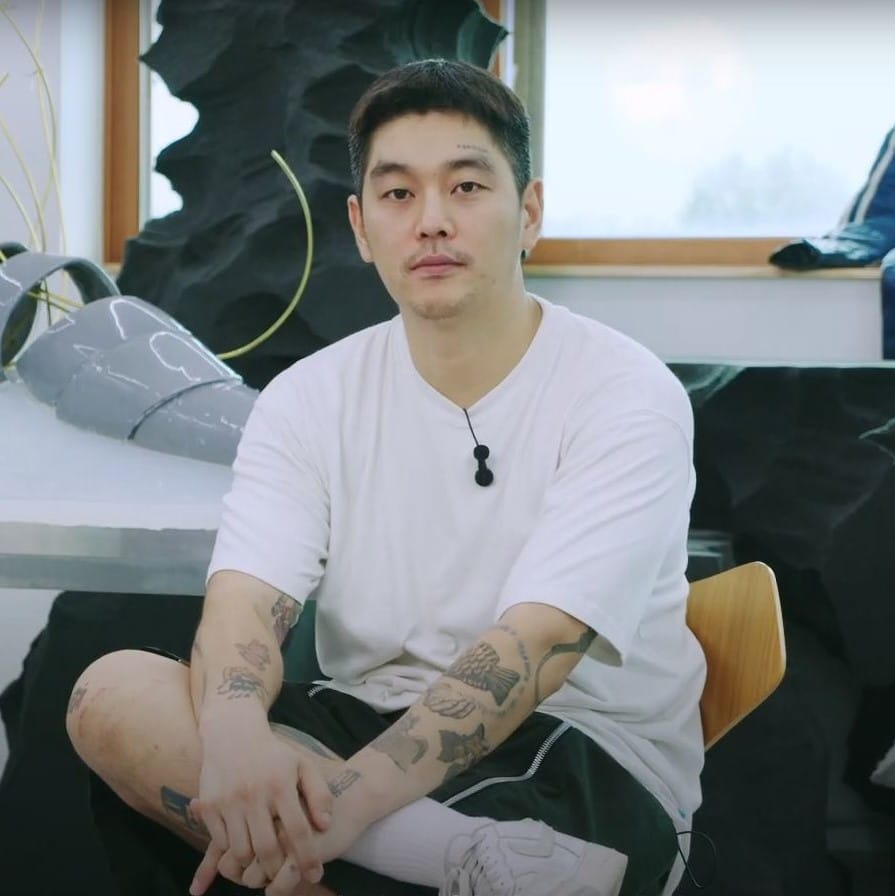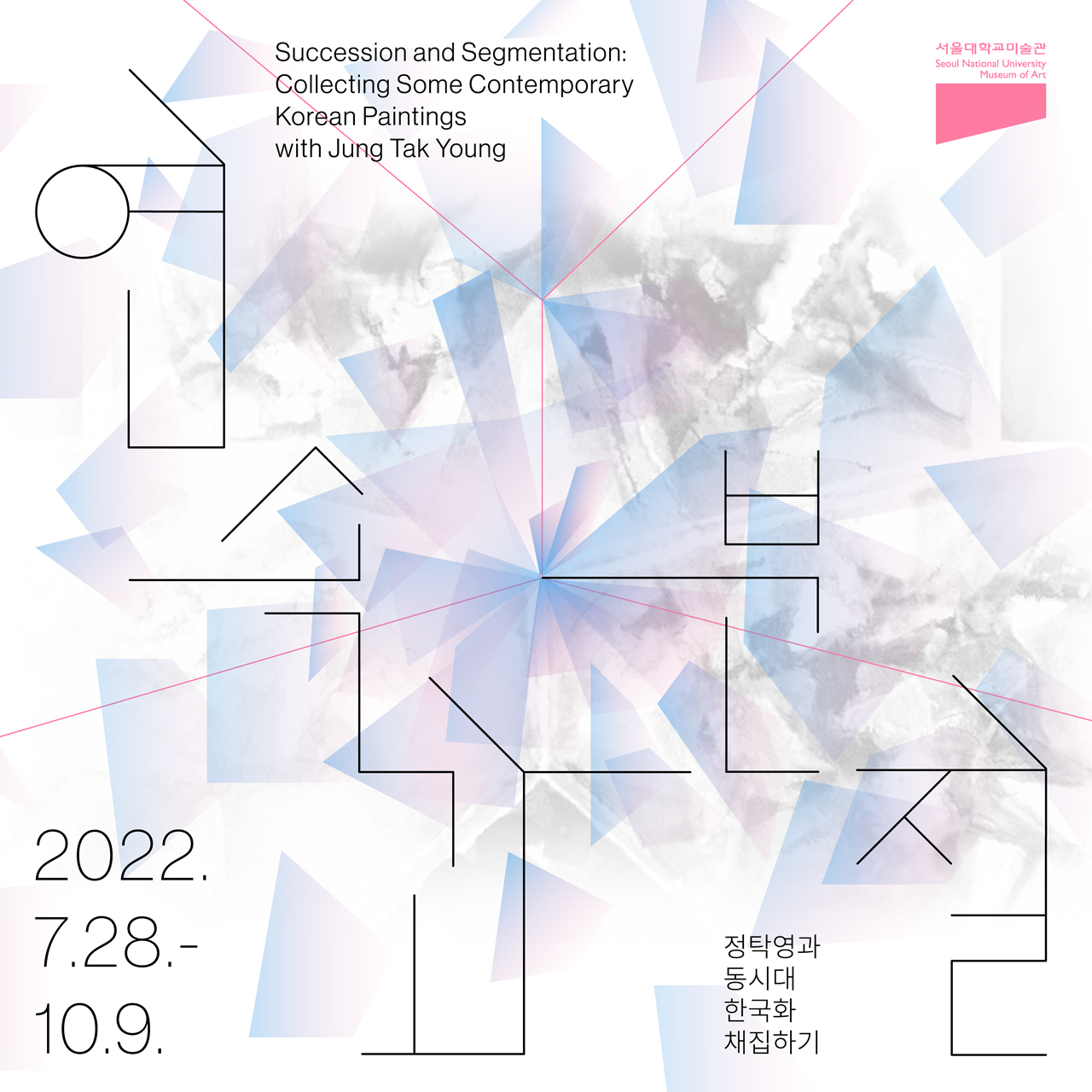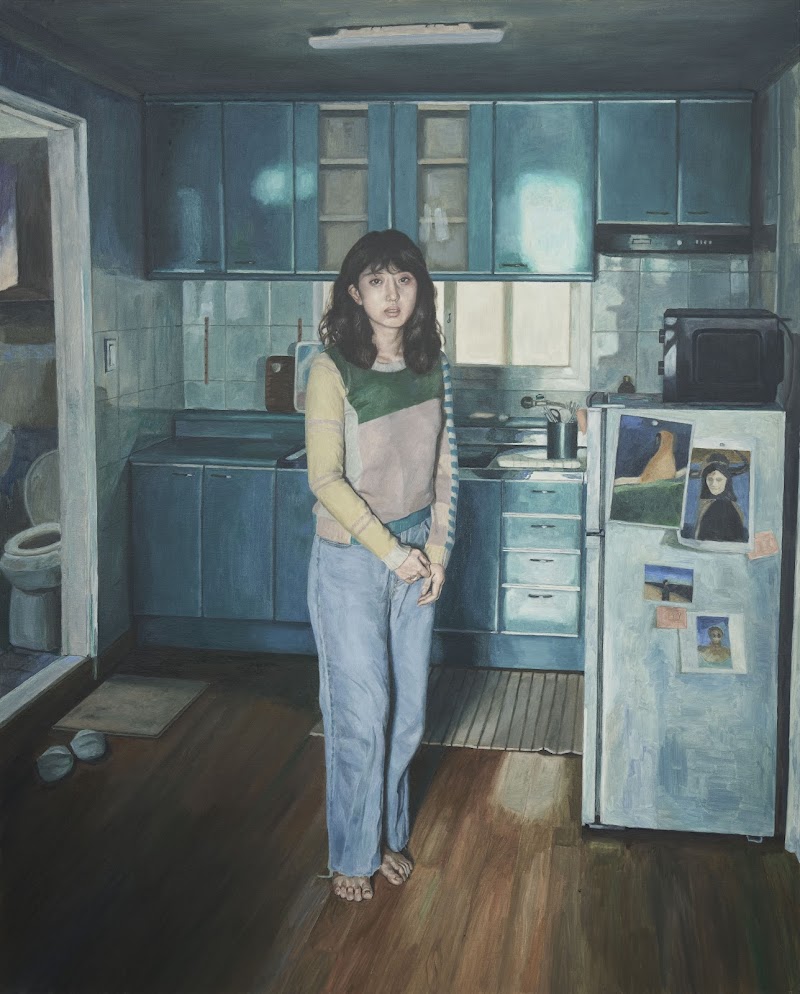 Poster image of "Succession and Segmentation: Collecting Some Contemporary Korean Paintings with Jung Tak Young" at SNUMOA, Seoul. July 28 - October 9, 2022. Courtesy of SNUMOA.
Poster image of "Succession and Segmentation: Collecting Some Contemporary Korean Paintings with Jung Tak Young" at SNUMOA, Seoul. July 28 - October 9, 2022. Courtesy of SNUMOA.Succession and Segmentation: Collecting Some Contemporary Korean Paintings with Jung Tak Young has opened at the Seoul National University Museum of Art (SNUMOA) to reflect on contemporary Korean painting and honor the late artist Jung Tak Young (1937–2012). The exhibition will be on view from July 28 to October 9, 2022.
As one of the key figures of the Mukrimhoe in the 1960s, an artist group whose mission was to pursue the spirit of Korean traditional painting in a new modern form, Jung Tak Young led the Ink-Wash Abstraction movement, which emerged in Korea after the introduction of Western abstract art, as part of the effort to modernize traditional painting. Jung continued to expand Korean painting, which led to the creation of “knife painting” in the 2000s, which was drawn on cardboard with a utility knife.
The exhibition will examine the artistic practices of artist Jung Tak Young and bring together the works of eleven living contemporary artists who are expanding and experimenting with traditional Korean painting from a new perspective.
 구나영(Gu Na Young), '삶의 노래 no.1,' 2015, 한지에 먹과 아크릴 채색, 147x210cm
구나영(Gu Na Young), '삶의 노래 no.1,' 2015, 한지에 먹과 아크릴 채색, 147x210cmGu Na Young (b. 1983)
Using Korean paper and ink, the artist Gu Na Young depicts a contemporary society in ink landscapes. The repetitive patterns of trees can also be seen as a group of people. The dark colors represent the weight of life, and the rough brushstrokes reveal the dynamism of modern people who live in the fast lane.

권세진(Kwon Sejin), '깊은 밤,' 2018, 캔버스, 종이에 먹, 130x193cm
Kwon Sejin (b. 1988)
Kwon Sejin creates large-scale ink works that resemble photographs. Kwon begins by photographing the urban landscape, enlarging the image, and then cutting it into small square pieces to draw the pictures with ink and Korean paper.
The artist reassembles these drawings into a single urban landscape. Kwon creates urban landscape paintings by applying the techniques of traditional landscape painting in accordance with the artist’s interpretation.
 김은형(Eun Hyung Kim), '뇌행성정류장,' 2021, 화선지에 먹, 220x420cm
김은형(Eun Hyung Kim), '뇌행성정류장,' 2021, 화선지에 먹, 220x420cmEun Hyung Kim (b. 1977)
Eun Hyung Kim uses traditional materials such as paper, ink, and brushes to create drawings, installations, and animations based on Eastern and Western classics such as operas and Korean traditional paintings. The artist uses these traditional mediums to express his inner thoughts through surreal scenes and characters and combines multiple narratives into one.
 김인영(Kim In Young), 'Floating space,' 2010, 캔버스에 아크릴과 에나멜 페인트, 145x226cm
김인영(Kim In Young), 'Floating space,' 2010, 캔버스에 아크릴과 에나멜 페인트, 145x226cmKim In Young (b. 1983)
Kim In Young creates abstract paintings reminiscent of traditional Korean landscape paintings using enamel paint. The heavily dripping paint, which has smooth and shiny surfaces, creates a sense of motion with a mixture of colors, and the thick character of the material emphasizes gravity. Instead of emphasizing the significance of the image, Kim’s works emphasize the “materiality” of the painting itself.

민재영(Min Jaeyoung), '회의실,' 2021, 한지에 수묵채색, 57x100cm (10EA)
Min Jaeyoung (b. 1968)
Min Jaeyoung focuses on colors that are rarely considered in traditional ink wash painting, as only black ink is used. The artist paints in the style of traditional Korean paintings, specifically using red, green, and blue colors, or RGB, which is the predominant color model for television. The artist depicts the lives of people in large cities, especially during the pandemic when many attempted to communicate through digital devices.
 손동현(Son Donghyun), '3P06,' 2021-2022, 종이에 먹, 탁본 먹, 194x520cm (overall 212x520cm), 4 panels.
손동현(Son Donghyun), '3P06,' 2021-2022, 종이에 먹, 탁본 먹, 194x520cm (overall 212x520cm), 4 panels.Son Donghyun (b. 1980)
Son Donghyun is a contemporary artist who defies the conventions of traditional Korean painting. Son’s artistic practices have been widely recognized for his portraits of popular culture figures rendered in the traditional style. Son’s previous works involved an in-depth examination of various figures to draw these portraits, but his recent practices have shifted to experimenting with new techniques for painting traditional landscapes. He creates a new landscape by crumpling hanji paper, spraying black ink to create mountain lines, and rubbing Lego pieces on the paper. Son also creates architectural/constructive installations with these paintings to extend the landscape paintings beyond the screens.

유승호(Yoo Seungho), '라멜라 양_1,' 2021-2022, 캔버스에 잉크와 아크릴릭, 245x183.6cm
Yoo Seungho (b. 1974)
Yoo Seungho’s works are often called “text landscape paintings” since the images are composed of letters rather than lines. The shapes and icons in the images can be identified from a distance, but as one approaches the paintings, the shapes disappear, and only the text remains visible. Using pens and paint, Yoo takes a further step in his recent work. By drawing lines with colored pens and blurring the image with a sprayer, the original image is transformed into an accidental shape and becomes an abstract image. In transforming and subverting his own “text landscape paintings,” Yoo renews the relationship between text and image.

이지영(Lee Jiyoung), 'Forest Stage- 역할극,' 2020, 장지에 연필, 130.3x161cm.
Lee Jiyoung (b. 1980)
In his works, Lee Jiyoung meticulously depicts zoo scenes but replaces the animals with a group of people using pencils. The primary material used to emphasize the interlayer structure and symmetrical compositions that both imprison and protect the characters in the drawings is a pencil, which imparts an artificial sense to the drawings. Through these structures, Lee attempts to create artificial landscapes that contain the conformity, desire, and deindividualization of today’s society.

진민욱(Jin Minwook), '소소경 逍小景-서울숲,' 2019, 비단에 수묵채색, 114x178cm.
Jin Minwook (b. 1980)
On silk, Jin Minwook describes in detail man-made natural objects, such as flower pots and viewing stones, that are prevalent in Korean cities. In the “So So Kyung” series, which translates to “small walk scenery,” Jin creates a landscape painting by arranging carefully observed objects discovered during walks through various Seoul neighborhoods. Jin subverts the traditional concept of landscape painting by depicting everyday life as opposed to majestic natural landscapes or glamorous cityscapes, thereby creating an easily accessible utopia.
 최은혜(Choi Eunhye), '의식의 밤 2,' 2019, 한지에 수묵채색, 130x193cm (2EA).
최은혜(Choi Eunhye), '의식의 밤 2,' 2019, 한지에 수묵채색, 130x193cm (2EA).Choi Eunhye (b. 1983)
Choi Eunhye expresses her inner self as a densely wooded forest on hanji, silk, or glass. Choi builds this “Mijirim,” or unknown forest, by constantly editing and reconstructing childhood memories, nostalgia, and impressions.
This unrefined forest covered with different flora symbolizes the artist’s desire for coexistence, and the repeated appearance of a “circle” or “moon” serves as a symbol of the harmonious union of different species. Choi extends the tradition of Eastern landscape painting, which seeks to depict landscapes that reflect inner selves, into contemporary art.
 허진(Hur Jin), '유목동물+인간-문명2016-25(동학혁명운동이야기2),' 2016, 한지에 수묵채색 및 아크릴, 130x162cm.
허진(Hur Jin), '유목동물+인간-문명2016-25(동학혁명운동이야기2),' 2016, 한지에 수묵채색 및 아크릴, 130x162cm.Hur Jin (b. 1962)
Traditional Eastern landscape painting reflects the artist’s inner thoughts, but artist Hur Jin departs from this practice. Hur expresses historical and actual issues through concrete narratives as opposed to abstract thoughts and ideas. In hopes of a world in which humans and nature coexist in harmony, the artist paints various images with nomadic animals or combines human figures with animal images to highlight today’s society’s reality through vibrant colors.























